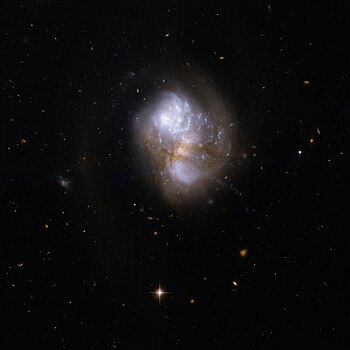IC 1623
| Galaxy IC 1623 |
|
|---|---|

|
|
| The galaxy pair IC 1623 recorded by the Hubble Space Telescope | |
| AladinLite | |
| Constellation | whale |
|
Position equinox : J2000.0 , epoch : J2000.0 |
|
| Right ascension | 01 h 07 m 47.2 s |
| declination | -17 ° 30 ′ 25 ″ |
| Appearance | |
| Morphological type | Double (3?) System |
| Brightness (visual) | 13.9 / 14.5 mag |
| Brightness (B-band) | 14.5 / 15.5 mag |
| Angular expansion | 1.5 ′ × 1.2 ′ |
| Position angle | 12 ° |
| Surface brightness | 13.2 / 13.4 mag / arcmin² |
| Physical data | |
| Redshift | +0.020067 ± 0.000077 |
| Radial velocity | (+6016 ± 23) km / s |
|
Stroke distance v rad / H 0 |
(269 ± 19) · 10 6 ly (82.6 ± 5.8) Mpc |
| history | |
| discovery | Lewis A. Swift |
| Discovery date | November 19, 1897 |
| Catalog names | |
| IC 1623 / 1623A / 1623B • PGC 4007/4009 • ESO 541-23 • MCG -03-04-03 / -03-04-04 • Arp 236 • VV 114 • NVSS J010747-173025 | |
IC 1623 = Arp 236 is an interacting galaxy pair in the constellation Whale south of the celestial equator , an estimated 269 million light years from the Milky Way . The system is in the final stages of merging.
Halton Arp organized his catalog of unusual galaxies into groups according to purely morphological criteria. This galaxy belongs to the class galaxies showing signs of splitting .
The object was discovered on November 19, 1897 by the American astronomer Lewis A. Swift .
literature
- Jeff Kanipe and Dennis Webb: The Arp Atlas of Peculiar Galaxies - A Chronicle and Observer's Guide , Richmond 2006, ISBN 978-0-943396-76-7
Web links
- Hubble Space Telescope
- SIMBAD query
- astronews.com: Picture of the day January 18, 2013
- Arp Atlas of Peculiar Galaxies
- Seligman Arp
Individual evidence
Attention: The sorting key “IC 1623” overwrites the previously used key “IC1623”.
